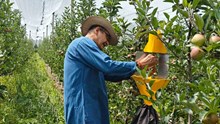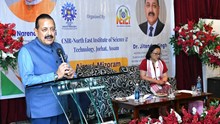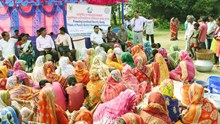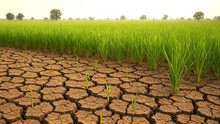
“We lost everything in one night. Yet our shift to natural farming ensured we weren’t left empty-handed.”
28-year-old Gurunath Shivshankar Kaute from Latur recalls the rains that drowned his soybean crop this year. For months, his family of eight had labored on their 11-acre farm, their hopes tied to the harvest. The crop stood lush, just a day away from being cut, when the skies opened. In a matter of hours, it was all gone.
“For a moment, I felt life had ended,” he says. Farming in Marathwada has long been a gamble with rain and debt. Earlier, Gurunath’s family’s reliance on chemical farming had only deepened the cycle of losses. Yet this time, all was not lost.
Turning to Natural Farming
Last year, Gurunath had been trained in Sri Sri Natural Farming through The Art of Living’s programs. He shifted one acre of sugarcane to natural methods, feeding the soil and recycling crop residues using cow-based preparations like Jeevamrut instead of chemicals or stubble burning. Much to his relief, that acre survived. Its returns were enough to keep his family afloat.
“Earlier, I used to get only 20% returns. Now the same land gives much better yield with fewer expenses,” he says.
In Latur, water scarcity has often been as cruel as crop failure. Borewells used to dry up by April, leaving families scrambling even for drinking water. But with The Art of Living’s Jaltara initiative, ponds and recharge pits began replenishing groundwater. Gurunath’s wells now yield water well into May and June. “That is why farming is still possible,” he explains.
Inner Strength Through Meditation
This turnaround has been both agricultural and personal. Gurunath’s father, battling cancer, finds strength in daily practices like Sudarshan Kriya and meditation. “Doctors gave him six months. It has been one and a half years. He is still with us. These techniques have really helped. Meditation gives him peace,” says Gurunath.
“For us, farming no longer feels like despair. Art of Living has given us courage. They taught us to care for water, for the soil, and for ourselves,” he adds.

A Second Chance in Vidarbha
In Paithan, Vidarbha, Vitthal Lipane faced a different struggle. On his 2.5 acres, crop failures, debt, and addictions had eroded his will to live. Suicide seemed like the only escape.
A friend encouraged him to attend the Youth Leadership Training Program (YLTP) by The Art of Living. There, Vitthal first experienced Sudarshan Kriya and yoga, alongside training in community leadership. “After the camp, negative thoughts stopped coming to my mind,” he says.
The program transformed more than his mindset. At a natural farming camp, Vitthal learned to prepare biofertilizers like Jivamrut and Ghanajivamrut, conserve moisture through mulching, and revive indigenous seed varieties. Inspired by his trainer Kishor Thorat, he converted his land entirely to natural farming.
The results were remarkable. From just 15 kg of wheat seed, he harvested 12 quintals per acre. Selling at Rs 5,000 per quintal, his gross income soared to nearly ₹60,000 per acre with minimal input costs. “This brought new life to me,” he says. His neighbors now visit his farm to learn natural farming methods from him.
The Power of a Strong Mind
For Vitthal, the transformation was as much mental as agricultural. Gurudev Sri Sri Ravi Shankar, the spiritual master behind The Art of Living’s natural farming movement, often reminds farmers:
"When the mind is weak, problems look enormous. When the mind is strong, the same problems look manageable."

Teachers on the Frontline
Behind Gurunath’s and Vitthal’s stories are Art of Living teachers dedicated to restoring the morale and prosperity of farmers. One such teacher is Amol, who once faced the brink of suicide himself. After learning Sudarshan Kriya in 2001, he became a full-time faculty member by 2005, teaching stress-relief and leadership programs in rural Maharashtra.
Recognizing Gurudev’s work with farmers, the former Chief Minister of Maharashtra consulted him on solutions for the Vidarbha crisis. Amol and his team revived water bodies, built recharge structures, led YLTP camps, and rebuilt morale. “In the last 15 years, not a single farmer suicide has been reported in the areas we worked in,” he says.
Why Farmer Mental Health Matters
Behind every statistic of crop loss or groundwater depletion is a human mind carrying unbearable weight. When farmers lose hope, it is not just an agricultural crisis, it is a societal fracture. Gurudev emphasizes that rural development is incomplete without nurturing inner resilience.

Through Sudarshan Kriya, meditation, and natural farming, farmers are discovering that real transformation begins within. For Gurunath, it means facing floods without breaking. For Vitthal, it means turning away from suicide toward life and purpose. For Amol, it means dedicating his life to lifting others from the brink he once faced.
















